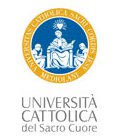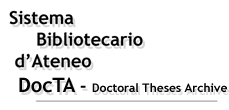|
|
DocTA - Doctoral Theses Archive >
Tesi di dottorato >
CORSO DI DOTTORATO IN SCIENZE DELLA PERSONA E DELLA FORMAZIONE >
Citazione:
Utilizza queste indicazioni per citare o creare un link a questo documento.
|
Chiesa, Federica. "TOMMASO STIGLIANI, DELLO OCCHIALE OPERA DIFENSIVA. EDIZIONE E COMMENTO", Università Cattolica del Sacro Cuore, XXXVI ciclo, a.a. 2022/23, Milano, [http://hdl.handle.net/10280/175451].
|
| Titolo: | TOMMASO STIGLIANI, DELLO OCCHIALE OPERA DIFENSIVA. EDIZIONE E COMMENTO |
| Autore/i: | CHIESA, FEDERICA |
| Tutor: | FRARE, PIERANTONIO |
| Coordinatore: | MARCHETTI, ANTONELLA |
| Lingua: | ITA |
| Abstract in italiano della tesi: | La tesi si articola in due sezioni. La prima è costituita da un’introduzione storico-critica organizzata in tre capitoli. Il primo ripercorre la travagliata relazione fra Tommaso Stigliani e Giovan Battista Marino a partire dal giovanile incontro a Napoli. Nel corso di quasi un ventennio, infatti, i rapporti tra i due furono assai ondivaghi, oscillando tra momenti di cordiale condivisione a episodi di ostilità e di scontro, anche fisico. Questo preparò il terreno all’aperta ostilità che scoppiò nel momento in cui Stigliani pubblicò il Mondo nuovo (1617), un poema sulla scoperta dell’America che conteneva in una breve sezione alcune stanze satiriche sul «pesciuomo», o «cavalier marino». L’assonanza con il suo nome non lasciò Marino indifferente e lo portò a minacciare Stigliani di ritorsioni. Per difendersi, Stigliani iniziò quindi a progettare l’Occhiale, prima in risposta generale alle opere di Marino, poi, quando venne pubblicato, come attacco specifico all’Adone. Il secondo capitolo è quindi dedicato alla ricostruzione della genesi dell’Occhiale, dalla prima notizia nota del progetto (1621) fino alla stampa del 1627, attraverso le informazioni fornite dall’epistolario, dai paratesti dell’Occhiale e dal manoscritto della Replica. Segue un’analisi dei paratesti, che forniscono ulteriori dati circa la cronologia dei fatti e lo schieramento dei personaggi coinvolti. Infine vengono ripercorse le due parti dell’Occhiale allo scopo di spiegarne in modo agile la struttura e i contenuti, con un focus sulla sospetta vicinanza tra le critiche di Stigliani e i motivi della proibizione dell’Adone e sull’uso parodico dei versi di Sissa e Vannetti. Infine, il terzo capitolo fornisce una ricostruzione della polemica scaturita dalla pubblicazione dell’Occhiale, soffermandosi in particolare sulla Difesa di Girolamo Aleandro e sulle tarde risposte di Angelico Aprosio. La seconda sezione della tesi contiene il testo commentato dell’Occhiale. L’edizione è accompagnata da una Nota al testo che fornisce un elenco delle correzioni apportate al testo, l’analisi puntuale degli scostamenti dei numeri di ottava tra l’Occhiale e l’Adone, le postille cassate e i criteri di trascrizione. In appendice è infine pubblicato il Proemio della Replica. |
| Abstract in inglese: | The thesis is divided into two sections. The first consists of a historical-critical introduction organized into three chapters. The first traces the troubled relationship between Tommaso Stigliani and Giovan Battista Marino beginning with their youthful meeting in Naples. Over nearly two decades, the relationship between the two was quite volatile, oscillating between moments of cordial sharing to episodes of hostility and confrontation, even physical. This set the stage for the open hostility that erupted the moment Stigliani published Mondo nuovo (1617), a poem about the discovery of America that contained in a short section some satirical stanzas about the "pesciuomo," or "sea-horse." The assonance with his name did not leave Marino indifferent and led him to threaten Stigliani with retaliation. To defend himself, Stigliani then began to design the Occhiale, first as a general response to Marino's works, then, when it was published, as a specific attack on the Adonis. The second chapter is then devoted to reconstructing the genesis of the Occhiale, from the first known mention of the project (1621) to its printing in 1627, through the information provided by the epistolary, the paratexts of the Occhiale and the manuscript of the Replica. This is followed by an analysis of the paratexts, which provide additional data about the chronology of events and the line-up of the characters involved. Finally, the two parts of the Occhiale are retraced to explain its structure and contents in an agile manner, with a focus on the suspected closeness between Stigliani's criticism and the reasons for the prohibition of the Adonis and the parodic use of Sissa and Vannetti's verses. Finally, the third chapter provides a reconstruction of the controversy that arose from the publication of the Occhiale, focusing in particular on Girolamo Aleandro's Defense and Angelico Aprosio's late responses. The second section of the thesis contains the annotated text of the Occhiale. The edition is accompanied by a Note to the text that provides a list of the corrections made to the text, a timely analysis of the deviations in octave numbers between the Occhiale and the Adone, the deleted annotations and the transcription criteria. Finally, the Proem of the Replica is published in the appendix. |
| Data di discussione: | 29-feb-2024 |
| URI: | http://hdl.handle.net/10280/175451 |
| È visualizzato nelle collezioni: | CORSO DI DOTTORATO IN SCIENZE DELLA PERSONA E DELLA FORMAZIONE
FACOLTA' DI SCIENZE DELLA FORMAZIONE
|
File in questo documento:
| File |
Dimensioni | Formato | Accessibilità |
|---|
| Chiesa_Stigliani_Dello Occhiale DEF.pdf | 93,41 MB | Adobe PDF | non consultabile
|
|
Accesso e utilizzo dei contenuti di DocTA
|



